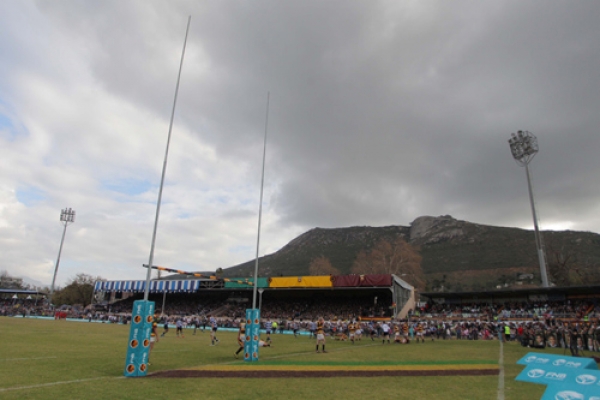To most people the sleepy little town of Paarl evokes images of luscious rolling golden fields of grapevines and fine wines. Truly this isn’t far from the truth as the wine industry has made Paarl the prosperous town it is today.Situated only about an hours drive from Cape Town it is not very hard to fall in love with this beautiful town. It has somehow preserved the rich cultural heritage associated with its history in such a modern world and these days the streets are lined with trendy restaurants and the very best in South African haute couture. It comes as no surprise then that it’s become a hub for the who’s who in South Africa to congregate. In stark contrast to its somewhat conservative history, the high streets of Paarl are these days lined with trendy young things and socialites. Surely this is the last place anyone would look for rugby talent. At first glance it seems that finding a game of rugby in a place like this would be like looking for a MacDonald’s in the middle of Paris. But as the old adage says, “Never judge a book by its cover,” and this holds very true for Paarl.
The soils in the area are such a deep, rich brown and are so amazingly fertile that one can easily see why some of the finest wines in the world have come from the area; however the soils have also for generations nurtured the tender roots of some of the country’s finest rugby talent. The town’s history is steeped with rugby glory. Names such as Corne Krige, Carel du Plessis, Mannetjies Roux, Schalk Burger Snr and Jnr, Jan Pickard and Kobus Wiese to mention but a few. The two schools responsible for this success have been rugby’s very own vineyards of talent, producing a standard of rugby revered all over the country and indeed all over the rugby world. Thus the clash between Paarl Boys’ High and Paarl Gimnasium has become the classic school sports derby in any way or form in the entire country, generating as much pomp and ceremony as a Test match, with crowds exceeding 25 000 fans. Lets take a closer look at the teams.
Paarl Boys’ High 
Established: 1868
Motto: Tandem Fit Arbor Surculus (Eventually the Acorn becomes an Oak)
Nickname: Boishaai (Boys-High)
Our first stop on the tour of this rugby mad town is its traditional all boys school, Paarl Boys High. Situated near the heart of the town, the school is one of the oldest in the country. It is also one of the most prestigious, producing some of the finest academic results in the country in addition to its obvious sporting pedigree. Flanked by leafy oak trees which provide a setting rivalled by few other educational institutions the world over, the school is a breathtaking haven of beauty and its perfectly preserved Victorian architecture provide the perfect foundation for the successes that have transpired within the walls of this grand old school, both on the sports field and in the classroom.
The school is predominantly a boarding school, with its boys hailing mostly from the Greater Western Cape and Boland. This boarding environment has influenced the culture and traditions of the school greatly and a sense of family is exceptionally prevalent wherever one walks. A stranger is welcomed with open arms to the Boishaai family and one feels immediately welcome and warmed by the reception. It is thus no surprise that the school has held generations of families in its warm bosom and many boys can trace their roots back two or three generations. It is also evident that Boishaai Old Boys as well as many who have been associated with the school usually maintain a lifelong relationship with the school. The former 1st XV coach, Elmo Wolfhardt for example, is an old Booishaaier and was in fact coached by current Deputy Headmaster and Boishaai legend Richard Visagie.
History
It all began in 1868 when a public meeting was held to discuss the feasibility of beginning a public school. After some deliberation the decision was made to establish a “First Class Public School”, and in July 1868 Rev. George Jeffreys was installed as the school’s first Headmaster.The initial years of the school were topsy-turvy and their first lodging, a granary on Zeederbergplein, proved to be too small for the growing population of the school.
In 1900 the school moved to its present location, originally the farm ‘Berlyn’. The turn of the century not only marked a change in location but an overall revolution of the school to become the powerhouse we know and love today. Under the guidance of the headmaster largely credited with the transformation of the school, Mr. PJ du Pré Le Roux, the name changed to “De Paarlsche Hoogere School voor Jongens” which influenced the present Afrikaans name of the school (Hoer Jongens Skool or HJS) and the school became one of the most prestigious institutions in the country. The school eventually became more popularly known as “Boys High” from which their nickname “Boishaai” is derived.
Rugby at Boishaai
Rugby has been played at Boishaai since the late 1800’s, making them one of the oldest school’s to continually play the game. Initially opposition was hard to come by since the transport links to nearby Cape Town were undeveloped and games against the Big Four Cape Town schools (the only rugby playing Cape Town schools to be established at the time) were unable to take place. Rather irregular games against the school now known as Paul Roos Gymnasium took place, a fixture which is still played out to this day. Since its inception, rugby has been an integral part of the Boishaai history. The list of Springboks and players who have played at Provincial level is monumental and Boishaai have one of the most impressive histories of top class rugby talent in the country, most probably rivalled only by the Diocesan College (Bishops), Paul Roos, rivals Paarl Gym and Grey College. Among the best was a man dubbed the “Prince of Wings”, Carel du Plessis as well as the genius Mannetjies Roux.
Springboks
Boy de Villiers, Hudie Hahn, Louis Louw, Theuns Kruger, Johnny Bester, Champion Myburgh, Boy Louw and his brother Fanie, Manie Geere, Ben du Toit, Ryk van Schoor, Theuns Briers, Piet du Toit, Mannetjies Roux, Haas Schoeman, Carel du Plessis, Wium Basson, Corné Krige, Gurthro Steenkamp
The very first match between Boishaai and Paarl Gym to be officially recognised as an “Interschools” (the name given to the annual match) game took place in 1915 and has taken place every year since. The traditions and hype around this game is rivalled by few rugby games around the world. So intense is the build-up and so great the honour of playing in an Interschools game that the 1st XV are largely kept in isolation from most of the on goings in the weeks leading up to the game so as to keep their minds focused on the game. One of the major traditions is the “Big Brag”, a very important ceremony in which all the members of the 1st XV are capped usually by a famous Old Boy. It is an evening of great honour for all the members of the 1st XV and their respective families and clearly highlights the importance of the game to the Boishaai players.
Paarl Gymnasium/Gimnasium
Established: 1858
Motto: Sol Iustitiae Illustra nios (Sun of justice, enlighten us)
Nickname: Gimmies
There can be no match without an opposition. So of course there can be no Interschools without a second team. The game and all its tradition and honour would be nothing without its other half, and who better to have as your traditional rivals than Paarl Gimnasium. They are without doubt one of the greatest rugby schools South Africa has ever seen. The mere mention of their name is associated with success. To have them as a traditional rival, regardless of what the results are, is an incredible honour for their opposition! Such is the esteem in which South Africa holds this incredible sporting school, and the praise is richly and highly deserved.
Superlatives are really no match for the achievements of this school on the rugby field. Boasting a incredible list of Springboks; Schalk Burger Snr and Jnr, Kobus Wiese, Jan Pickard, Jean de Villiers to name but a few; and an even longer list of provincial stars it is little wonder why in excess of 25 000 rugby lovers and spectators turn out in their droves to watch their biggest match of the season against their arch enemies Boishaai.
The school, situated a little further north of the town, is another classic example of old and new in much the same way as the town. It’s a reflection of Paarl itself; proud of its heritage and history yet at the forefront of schooling in the 21st century with top of the range facilities, combining the old and the new in perfect harmony. The school is filled with these sorts of opposites in unison, the most striking example being that it is a co-educational institution. The fact that boys account only for about 500 of the some 1100 pupils is a testament to the incredible talent factory that this school has become, as the numbers from which to choose from are moderate in comparison with rivals.
History
The junior part of Gimmies was established in 1858, long before the High School. It was established by Rev. Van Lingen as a Dutch Christian school for boys in the centre of the town. The school was later moved to the present location north of the town, on a hill surrounded by serene vineyards and the imposing world famous Paarl Rock. Its distinctive green, maroon and gold colours were chosen in 1903, and have remained since, being as much apart of the heritage of the school as the students who have trodden on its hallowed grounds.
Paarl was at the centre of the movement for Afrikaans to be recognised as an official language and Paarl Gym was instrumental in the movement, culminating with the school officially changing its medium of instruction to Afrikaans in the mid-1930’s, and to this day it remains an Afrikaans medium school.
The seperation of the High and Junior schools took place in 1964. It is also the year that the very first girls were admitted to the school.
Rugby at Gimmies
The history of rugby at Gimmies is tinted with the legendary green and gold of the Springboks and rugby at the school had its roots in the late 1800’s. In 1895 the pupils implored the headmaster for a rugby club to be founded at the school. The initial response was in the negative and the request was dismissed by saying that if the boys wanted exercise they should work in the garden. One can’t help but imagine if the decision was not changed, what a tragedy it would have been to lose what is today one of South Africa’s greatest rugby institutions to the annals of history.
Nevertheless, organised sport, and more specifically rugby begun at the school in 1902. In the early years, as the teams were essentially a rugby club and no strict age-groups were defined, the staff frequently turned out in the colours of the school. One peculiar feat, as a result of this technicality, was the then headmaster FC Wahl captained the school’s 1st XV, an odd record not matched by many schools around!
The early signs that this school was destined for greater things on the rugby field was when Gimmies managed to beat the rest of Paarl in a scheduled match, a resounding and rather ominous danger for schools who were to face Gimmies in later years as Paarl RFC were considered to have some of the best club rugby players in the country in those years. Gimmies’ pedigree at provincial level cannot be denied with over a 100 players having represented Western Province. What is even more impressive is the list of Springboks, in spite of the moderate numbers at hand. The school manages to put 20 teams on a rugby field week in and week out. Not only are these teams competitive, they are usually some of the best in the province and the country, an incredible achievement for only 500 boys.
Springboks
Boy de Villiers, Steve Joubert, Pietie le Roux, Japie le Roux, Gerald Thompson, Attie van Heerden, JC van der Westhuizen, Pierre de Villiers, Manus de Jongh, PK Morkel, Jan Pickard, Hugo van Zyl, Wynand Mans, Schalk Burger Snr., Kobus Burger, Kobus Wiese, Balie Swart, Mornay Visser, Pieter and Chris Rossouw, De Wet Barry, Marius Joubert, Jean de Villiers, Schalk Burger Jnr.
The Interschools match against rivals Boishaai has been the biggest honour for these aforementioned legends who have donned the Green and Gold, during their schoolboy years. Some might even say that for a Gim or Boishaaier it rivals Craven Week selection. This incredibly intense rivalry which takes place at the Faure Street Stadium annually has lead to the establishment of traditions which hold a special place not only in the hearts of Gim Boys but also Gim girls. Every Interschools the respective Gim 1st XV votes for the most beautiful Gim girl to be the Sjampagne Meisie (Champagne Girl), a massive honour for any Gim girl, whose responsibilities include handing out the traditional rosettes emblazoned with the school’s legendary colours. A similar tradition also takes place at Boishaai with a girl from Paarl Girls’ High being chosen.
On the 1st August 2015, the curtain will slowly lift on yet another instalment of this epic match, and perhaps the old cliché is more apparent in this match than in any other school rugby match; it is not whether you win or lose that is important, but having competed in one of South Africa’s greatest rivalry that must surely be the most supreme honor.




